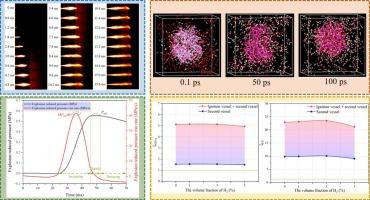低体积分数 H2 对通过连接容器的 AlH3 粉尘爆炸特性和机理的影响
IF 4.5
2区 工程技术
Q2 ENGINEERING, CHEMICAL
引用次数: 0
摘要
在储存和使用 AlH3 的过程中,少量 H2 很容易分解,形成多相复合体系,增加爆炸危险。本文讨论了 AlH3 粉尘诱发低浓度 H2 爆炸的情况,以及连通容器的排气特性。结果表明,当 H2 的浓度为 1 % 和 3 %(低于 H2 的爆炸下限(4 %))时,H2 不易燃,爆炸为粉尘驱动爆炸。当 H2 体积分数为 5 % 时,双燃料驱动爆炸占主导地位,最大爆炸压力、减压、放喷火焰长度和速度均达到顶峰。利用分子动力学模拟探讨了 AlH3 与 H2 的微观反应机理。同时,针对 AlH3 粉尘爆炸在低 H2 气氛下排出的安全策略,NFPA 68 和 EN 14491 标准对排出火焰长度进行了有效预测,为 AlH3 的应用和安全设计提供了重要启示。本文章由计算机程序翻译,如有差异,请以英文原文为准。

Effect of low volume fraction of H2 on explosion characteristics and mechanism of AlH3 dust via connected container
During the storage and use of AlH3, a small amount of H2 is easily decomposed, forming a multiphase composite system that increases explosive hazard. This article discussed the AlH3 dust inducing low concentration H2 explosion and venting characteristics by a connected vessel. The results show that when the concentration of H2 was 1 % and 3 %, which was lower than the lower explosive limit of H2 (4 %), H2 was non-flammable, and the explosion was dust-driven explosion. At H2 volume fraction of 5 %, a dual-fuel-driven explosion dominated, culminating in the maximum explosion pressure, reduced pressure, venting flame length, and velocity. The microscopic reaction mechanism of AlH3 with H2 was explored using molecular dynamics simulations. Meanwhile, for the security strategy of AlH3 dust explosion venting with low H2 atmosphere, the NFPA 68 and EN 14491 standards predicted the venting flame length effectively, offering critical insights for the application and safety design of AlH3.
求助全文
通过发布文献求助,成功后即可免费获取论文全文。
去求助
来源期刊

Powder Technology
工程技术-工程:化工
CiteScore
9.90
自引率
15.40%
发文量
1047
审稿时长
46 days
期刊介绍:
Powder Technology is an International Journal on the Science and Technology of Wet and Dry Particulate Systems. Powder Technology publishes papers on all aspects of the formation of particles and their characterisation and on the study of systems containing particulate solids. No limitation is imposed on the size of the particles, which may range from nanometre scale, as in pigments or aerosols, to that of mined or quarried materials. The following list of topics is not intended to be comprehensive, but rather to indicate typical subjects which fall within the scope of the journal's interests:
Formation and synthesis of particles by precipitation and other methods.
Modification of particles by agglomeration, coating, comminution and attrition.
Characterisation of the size, shape, surface area, pore structure and strength of particles and agglomerates (including the origins and effects of inter particle forces).
Packing, failure, flow and permeability of assemblies of particles.
Particle-particle interactions and suspension rheology.
Handling and processing operations such as slurry flow, fluidization, pneumatic conveying.
Interactions between particles and their environment, including delivery of particulate products to the body.
Applications of particle technology in production of pharmaceuticals, chemicals, foods, pigments, structural, and functional materials and in environmental and energy related matters.
For materials-oriented contributions we are looking for articles revealing the effect of particle/powder characteristics (size, morphology and composition, in that order) on material performance or functionality and, ideally, comparison to any industrial standard.
 求助内容:
求助内容: 应助结果提醒方式:
应助结果提醒方式:


